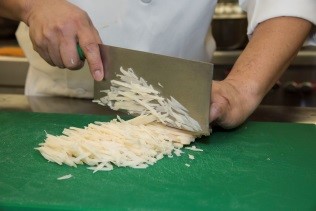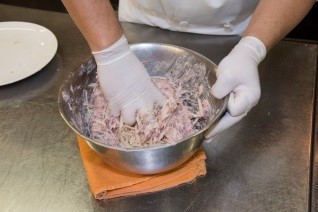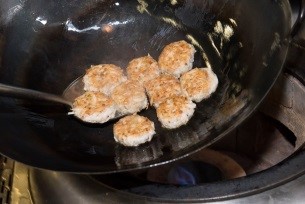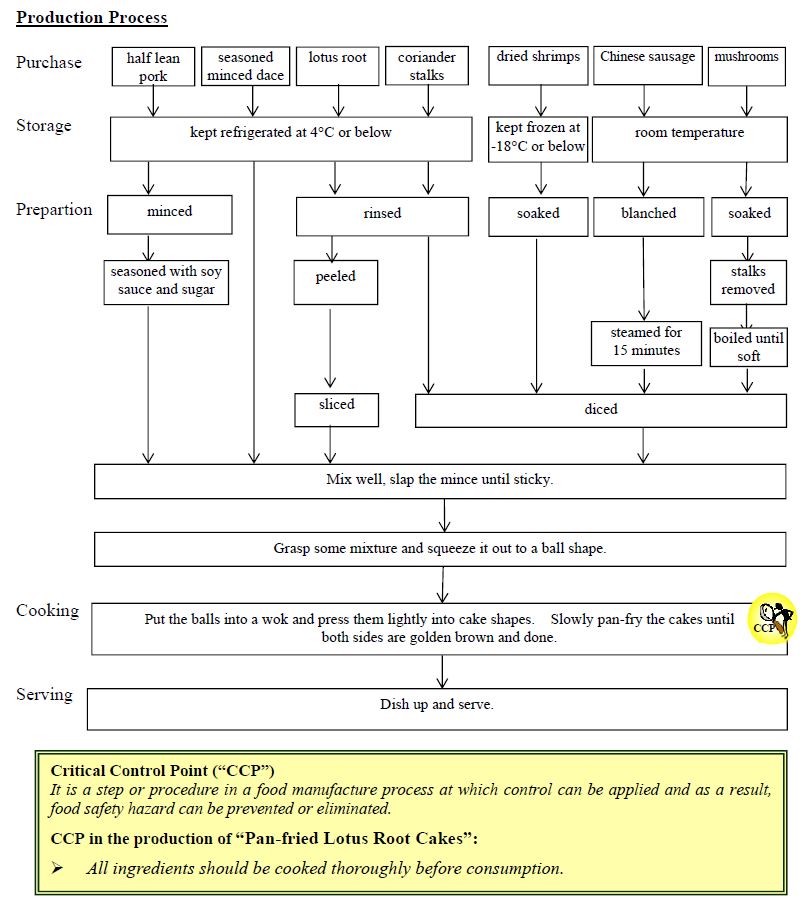
Feature Article
Hong Kong's Action on Salt and Sugar Reduction: Read Labels, Choose Smartly
“Salt/Sugar” Label Scheme for Prepackaged Food Products
The Committee on Reduction of Salt and Sugar in Food (CRSS), the Food and Health Bureau and the Centre for Food Safety (CFS) jointly introduced a voluntary “Salt/Sugar” Label Scheme for Prepackaged Food Products with the support of the food trade in October 2017. The scheme is an initiative of the CRSS to promote low-salt-and-sugar diets in the community.
Reduction of Dietary Sodium and Sugar
Dietary sodium and sugar intakes are closely related to health. Excessive sodium intake will increase the risk of developing hypertension, stroke and coronary heart disease, while excessive intake of dietary sugar may cause overweight and dental caries.
To echo with the initiatives of the World Health Organization (WHO), promotion of reducing salt and sugar intake for the general population in Hong Kong has become a highlight on the Government's Policy Agenda. For this purpose, the CRSS has been established to advise the Government on the formulation of policy directions and work plans to reduce the intake of salt and sugar by the public, as well as to reduce salt and sugar contents in food.
“Salt/Sugar” Label Scheme for Prepackaged Food Products
The scheme is jointly introduced by the Government and the CRSS to assist consumers to easily identify low-salt-and-sugar products, and facilitate the public to select food with less salt and sugar by making reference to the “Salt/Sugar” Labels (the Labels). It is also hoped that the scheme could serve as a catalyst for the trade to provide more varieties of low-salt-low-sugar products for consumers. Prepackaged food products with the Labels are expected to be available on the market soon.
The Labels can be displayed on all prepackaged food products that fit the definitions of “low salt”, “no salt”, “low sugar” or “no sugar” under the Food and Drugs (Composition and Labelling) Regulations (Cap.132W) (see Figure 1).
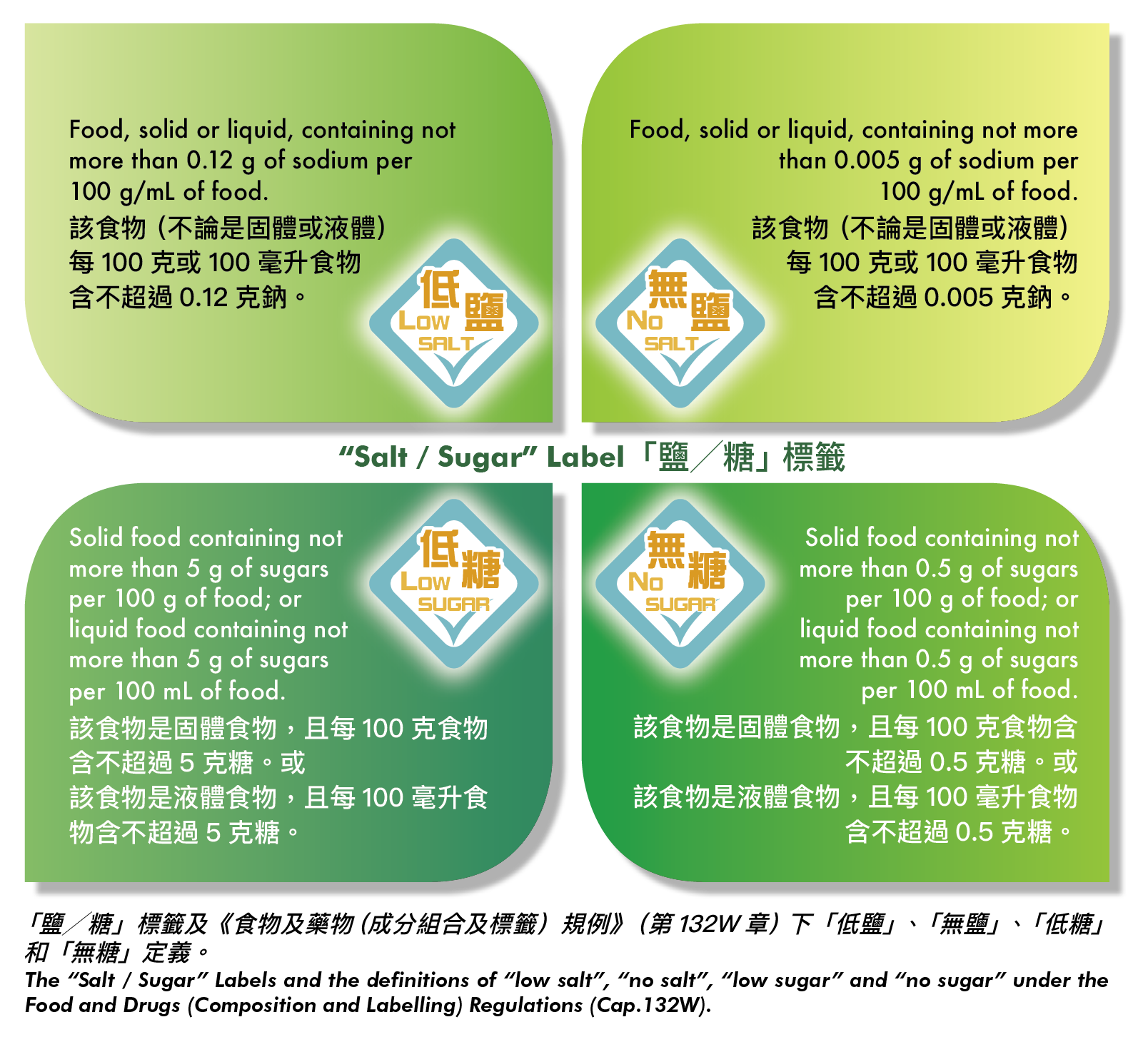
(Figure 1)
Printed in colour or black and white, the Labels are available in Chinese, English and bilingual versions.
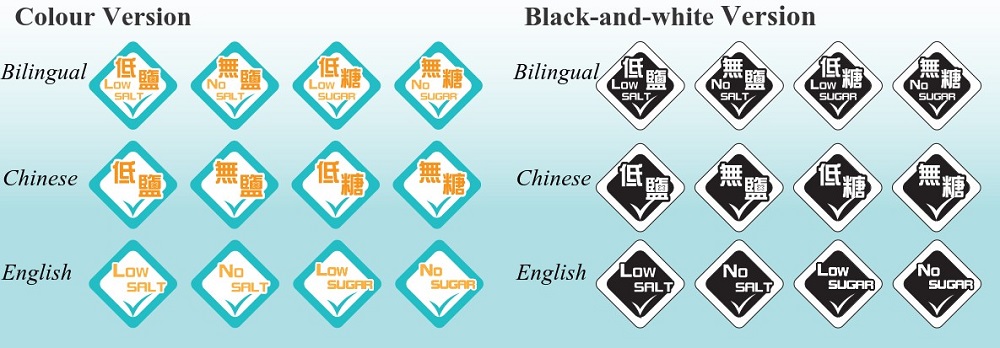
How to Participate in the Scheme
Participation in the scheme is voluntary and no approval from the CFS is required. Trade members who wish to join the scheme can simply submit the Notification Form of Implementation of “Salt/Sugar” Label Scheme for Prepackaged Food Products to the CFS. Information of the products sold under the scheme will be uploaded to the CFS website.
The selected Labels should be printed or stuck prominently on the food packaging. The trade may decide the size of the Labels on their own. However, they should be clear and legible.
For the designs of the labels and details of the scheme, please visit the CFS’s dedicated webpage at
http://www.cfs.gov.hk/english/programme/programme_rdss/programme_Salt_Sugar_Label_Scheme.html
Less-salt-and-sugar Diet
A less-salt-and-sugar diet is the suitable choice. To avoid adverse health effects caused by excessive intake of salt and sugar, the public is encouraged to develop a healthy eating habit with less salt and sugar. Next time when you purchase prepackaged food products, remember to read the nutrition labels and choose food with lower sodium and sugar contents. Allow your taste buds to be accustomed to food with less salt and sugar.
Readers' Corner
I. Patulin in Apple Juice
In August last year, the CFS announced that a beverage sample imported from Australia was found to contain patulin at a level of 93 parts per billion (ppb), which exceeded the action level of 50 ppb adopted by the CFS. What are the factors contributing to the formation of patulin? What foods are commonly associated with patulin occurrence? What measures can food manufacturers take to reduce the risk of patulin contamination in food production?
Patulin is a toxin produced by a number of different moulds such as penicillium and aspergillus. It can be found in damaged or mouldy fruit, particularly apples. If contaminated apples are used to make juice or other food products, patulin is likely to be carried through to the final products.
Currently, there is no specific legislation in Hong Kong regulating the level of patulin in food. However, the local food law stipulates that all food for sale must be fit for human consumption. Making reference to the Codex Alimentarius Commission (Codex) standards, the CFS adopts an action level at 50 ppb for patulin in apple juice and apple juice used as an ingredient in other beverages. Regarding the above-mentioned sample with patulin exceeding the action level, the CFS has informed the distributor concerned of the irregularity, and the distributor has stopped selling the affected batch of products, removed them from shelves and initiated a product recall according to the CFS' instructions. Apart from the said sample, some 20 other apple juices and apple juice drinks were tested for patulin. The results were all satisfactory. The CFS will continue to monitor the level of patulin in apple juice products.
Animal studies showed that exposure to a high level of patulin over a short period of time could cause abnormal increase in blood flow, bleeding and open sore in the mucous membrane of the gastrointestinal tract. As to whether patulin can cause cancer in humans, the International Agency for Research on Cancer concluded that no evaluation could be made as there was inadequate evidence for carcinogenicity.
Control of patulin levels in apple juice is achievable through good practices such as the Good Manufacturing Practice (see Figure 1). In this connection, the Codex has issued a code of practice with recommendations on the prevention of patulin contamination and the reduction of patulin levels in apple juice and apple juice drinks.
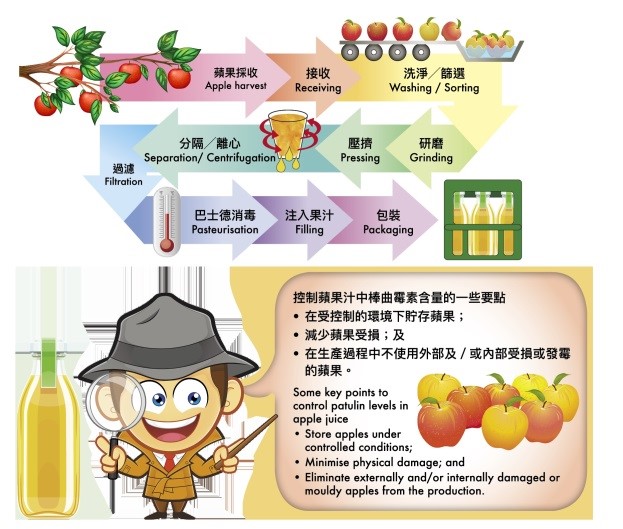
Figure 1: A flowchart showing the general process of apple juice production and some key points to control the levels of patulin in apple juice.
Since mould growth usually occurs in warm and humid environment, harvested apples should be stored under controlled conditions (e.g. kept refrigerated). They should also be handled as gently as possible to minimise physical damage as any bruising will encourage patulin formation.
Cutting off the mouldy parts of apples prior to pressing will not necessarily remove all the patulin present in the fruit as some patulin may have diffused into the seemingly “healthy” tissue. Apples that are externally and/or internally damaged or mouldy should not be used for apple juice production. For safety reasons, apples should be regularly examined for internal damage or rots by cutting them open for cross-sectional examination before pressing.
Prepackaged apple juices are usually heat-treated (e.g. by pasteurization) for elimination of enzymes and certain microorganisms to prolong the shelf life of the product. While pasteurisation will generally destroy the mould, it cannot remove the patulin which is already present in the fruit.
Advice to the Trade
- Adopt GMP by making reference to the Codex Code of Practice in apple juice production.
- Do not use damaged or mouldy apples for apple juice production. Before pressing, cut the apples and check the cross sections for any damage or mould.
- Store apples and apple juices under proper conditions to prevent microbial development and patulin formation.
II. Metallic Contaminants and Food Safety – Cadmium
Cadmium is one of the four metallic contaminants identified as a major public health concern by the WHO. The International Agency for Research on Cancer considered that there was sufficient evidence of carcinogenicity of cadmium and cadmium compounds in humans upon occupational exposure, and hence classified these substances as Group 1 agents (i.e. carcinogenic to humans).
Health Effects
Despite the above, cadmium does not appear to have significant genotoxic and carcinogenic potential in food consumption. Acute cadmium intoxication due to dietary exposure is also very unlikely. As for chronic cadmium poisoning, it is the kidney which is mostly affected, as cadmium accumulates mainly in the kidney and may lead to irreversible kidney damage. High intake of cadmium can also lead to disturbances in calcium metabolism and the formation of kidney stones. In addition, people living or working in cadmium-contaminated areas may experience bone softening and develop osteoporosis.
A local study revealed that the dietary exposure to cadmium of the local population fell below the health-based guidance value (HBGV) (the dietary exposures of average and high consumers of the population accounted for 33% and 75% of the HBGV respectively), indicating that the general population was not at risk due to cadmium. The HBGV is an estimate of the amount of a chemical that can be ingested over a defined period without appreciable health risk.
Cadmium in Our Diet
Cadmium in soil and water can be taken up by certain crops and aquatic organisms and accumulate in the food chain. The major dietary sources of cadmium are “vegetables and their products”, “fish and seafood and their products” and “cereals and their products”, which contribute to 36%, 26% and 21% of the total exposure respectively.
Vegetables
Vegetables may absorb cadmium through the roots. Atmospheric fallout will also contribute to the presence of cadmium in vegetables, especially leafy vegetables. In general, cadmium accumulates in the leaves of plants. Therefore, higher levels of cadmium may be found in leafy vegetables such as spinach. Some wild edible fungi may also contain relatively high levels of cadmium.
Adequate intake of vegetables is an essential component of healthy eating. Maintaining a balanced diet with a variety of leafy and non-leafy vegetables can help us avoid excessive exposure to cadmium from a small range of food items. Washing vegetables and peeling root and tuber vegetables can also reduce cadmium contamination to some extent.
Seafood
Crustaceans are natural accumulators of cadmium. The Food Surveillance Programme of the CFS has found some crab samples, in particular brown crabs, containing high levels of cadmium. Overseas and local studies have shown that the levels of cadmium in the muscle meat of crab claws and legs (commonly referred to as “white meat”) are low but the levels in the “brown meat” (including gonads and digestive glands) are usually higher (see figure). To reduce the risk, people who consume more crabs, particularly brown crabs, are advised to limit or avoid the consumption of brown meat.
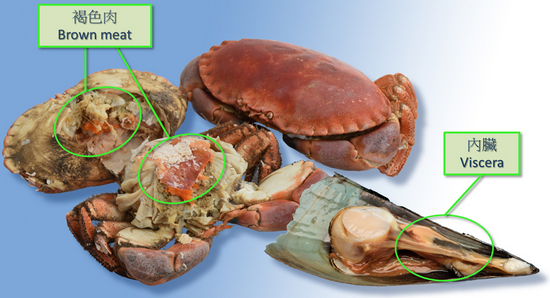
Molluscs such as oysters and scallops will absorb contaminants in the water during filter feeding. Like other contaminants, cadmium is therefore concentrated in the viscera of molluscs. To minimise the risk of cadmium intake, excessive consumption of shellfish should be avoided. The viscera of scallops should also be removed before cooking and only the adductor muscles should be consumed.
The cadmium concentrations are generally low in fish.
Cereals
Due to high consumption, cereals (including wheat, rice and their derived products) are one of the major dietary sources of cadmium in the local population. Cadmium is mainly found in the outer parts of the grain, and can be wholly or partly removed during the milling process. Nevertheless, consumption of whole grains is generally recommended as part of a healthy diet due to the presence of important nutrients such as dietary fibre. All in all, it is essential to take a balanced and varied diet.
Advice to the Trade
- Washing vegetables and peeling root and tuber vegetables can reduce cadmium contamination to some extent.
- The viscera of scallops should be removed before cooking.
News on New Dishes
Pan-fried Lotus Root Cakes
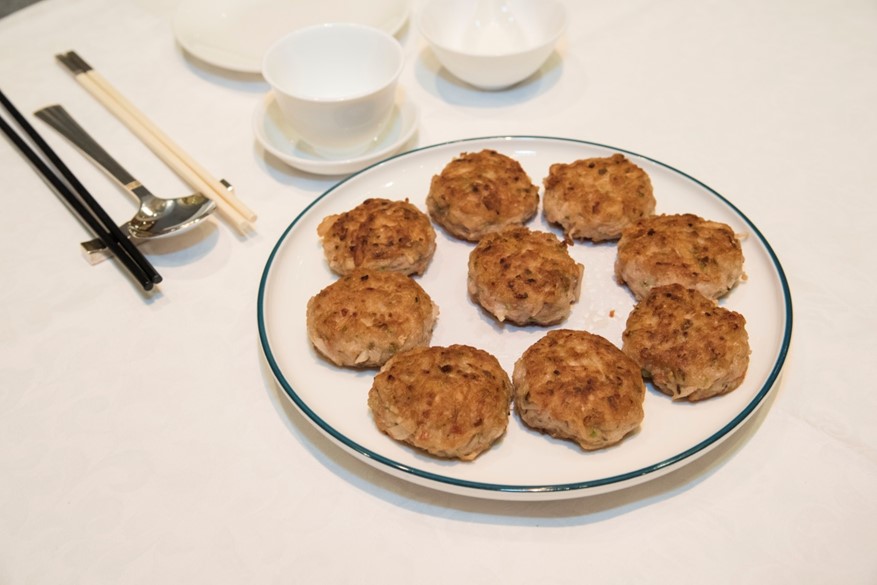
Shunde, also known as Fengcheng (the city of phoenix) in old times, is a place in Guangdong Province renowned for its exquisite cuisine. As the saying goes, “Guangzhou (the capital city of Guangdong) is the paradise of food; Shunde the home of famous chefs.” In this issue, we bring you a homely dish from Shunde: Pan-fried Lotus Root Cakes. Mr HO Wai-sing, Chinese Executive Chef of The Royal Garden Chinese Restaurant (a signatory of the Food Safety Charter), will show us how this delicious dish is prepared.
| Preparation Steps | Small Tips, Big Wisdom | |
|---|---|---|
|
Receiving
|
Purchase the ingredients such as lotus root, pork, minced dace, dried shrimps, mushrooms, Chinese sausage and coriander from approved and reliable suppliers. | Upon receipt of the ingredients, check carefully to ensure their freshness. Vegetables and meat should be refrigerated at 4ºC or below. Dry goods (e.g. mushrooms) should be stored in lidded containers and kept cool and dry on a shelf to avoid dampening or deterioration. |
|
Rinsing & Cutting
|
Rinse the ingredients thoroughly. |
Rinsing the ingredients thoroughly under clean running water can effectively reduce the risk of pesticide intake. |
|
Mixing and Slapping
|
Place the seasoned minced pork and the diced ingredients in a mixing bowl. Add in plaice powder and the minced dace, blend well. Then put in lotus root shreds. Mix well and slap the mince until sticky. |
Adding natural spices to food can reduce the use of seasonings such as salt and sugar. |
|
Pan-frying
|
Heat up a wok, add in some oil and switch to medium fire. Put the balls into the wok and press them lightly into cake shapes. Slowly pan-fry the cakes, toss them from time to time. Fry both sides until golden brown and done. Dish up and serve. |
If food is not consumed immediately, it should be cooled as quickly as possible and refrigerated within two hours. |
Tips from the Chef:
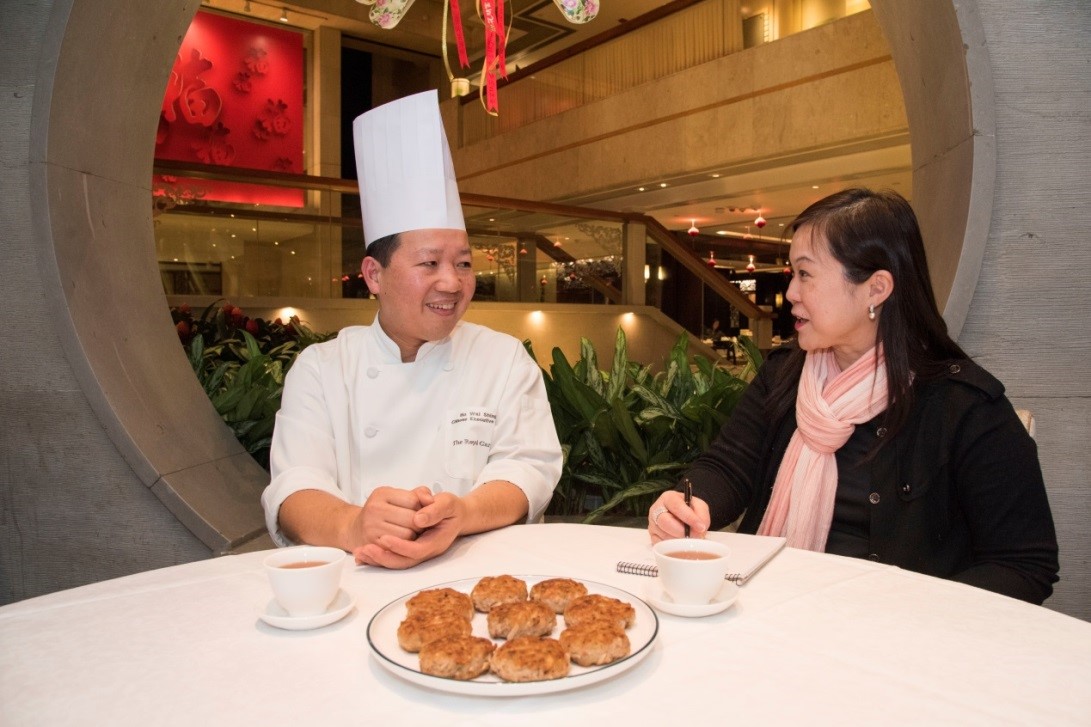
- For simplicity and convenience, use seasoned minced dace (5 taels) available from fish stalls.
- Mincing streaky pork and pork brisket (6 taels each) together can yield a smoother and tenderer meat texture.
- Dried shrimps which are soaked until soft before peeling and dicing give a better taste and texture.
- To make the mushrooms sweeter in scent, soak them until soft, then remove the stalks. Add in ginger slices and green onion sections. Cook the mushrooms until tender and dice them.
- To make the dish less greasy, use extra lean Chinese sausages. Blanch and steam for about 15 minutes before dicing.
- Use only the stalks of coriander and chop them finely for a better texture.
- Rinse the lotus root (5 taels). Soak it in water and keep it refrigerated to prevent it from turning brown. Peel and cut it into thick shreds only before cooking. In this way, the shreds will remain crispy.
- Add plaice powder instead of salt to the mixture. This can enhance the flavour and reduce the use of salt. It is not difficult to make plaice powder on your own. Bake a plaice fillet in the oven at 90ºC until it is brittle, then tear the fillet into pieces and grind them into powder. Make only a small amount of plaice powder each time to avoid the loss of aroma due to prolonged storage.
- Pan-frying the lotus root cakes with a non-stick pan at home helps reducing the amount of oil used. The dish can also be prepared by steaming, which ensures healthy eating without affecting the taste.
Food Safety Plan Corner
Pan-fried Lotus Root Cakes
Ingredients:
Half lean pork, seasoned minced dace, lotus root, dried shrimps, mushrooms, Chinese sausage, coriander stalks.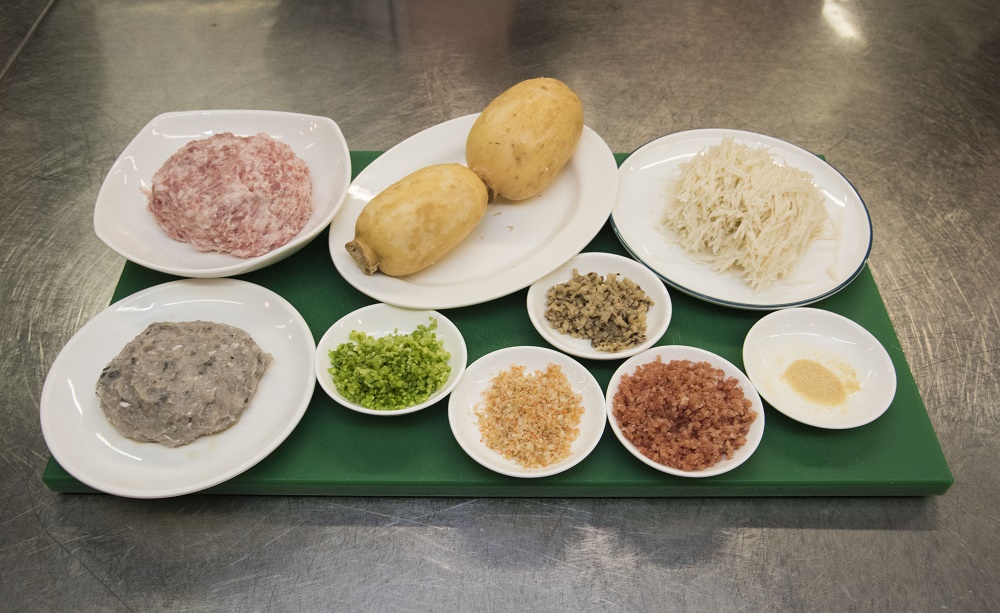
Steps:
- Take out some mushrooms and a Chinese sausage from the dry goods shelf.
- Soak the mushrooms in water. Remove the stalks. Cook the mushrooms in boiling water until soft. Dice them for later use.
- Blanch the Chinese sausage and steam it for about 15 minutes. Dice it and set aside.
- Take out some dried shrimps from the freezer set at -18ºC or below. Soak them in water for about 10 minutes until soft. Dice them and set aside.
- Take out the lotus root, coriander stalks and half lean pork that are refrigerated at 4ºC or below. Rinse the lotus root and coriander stalks. Peel and cut the lotus root into thick shreds and finely chop the coriander stalks. Mince the half lean pork and season it with a little soy sauce and sugar.
- Place the above ingredients in a mixing bowl. Add in seasoned minced dace and plaice powder. Mix well, and slap the mince until sticky.
- Grasp some mixture and squeeze it out to a ball shape. Place the balls on a plate for later use.
- Heat up a wok, add in some oil and switch to medium fire. Put the balls into the wok and press them lightly into cake shapes. Slowly pan-fry the cakes, toss them from time to time. Fry both sides until golden brown and done. Dish up and serve.
Briefing of Activities
Second Hong Kong Population-based Food Consumption Survey
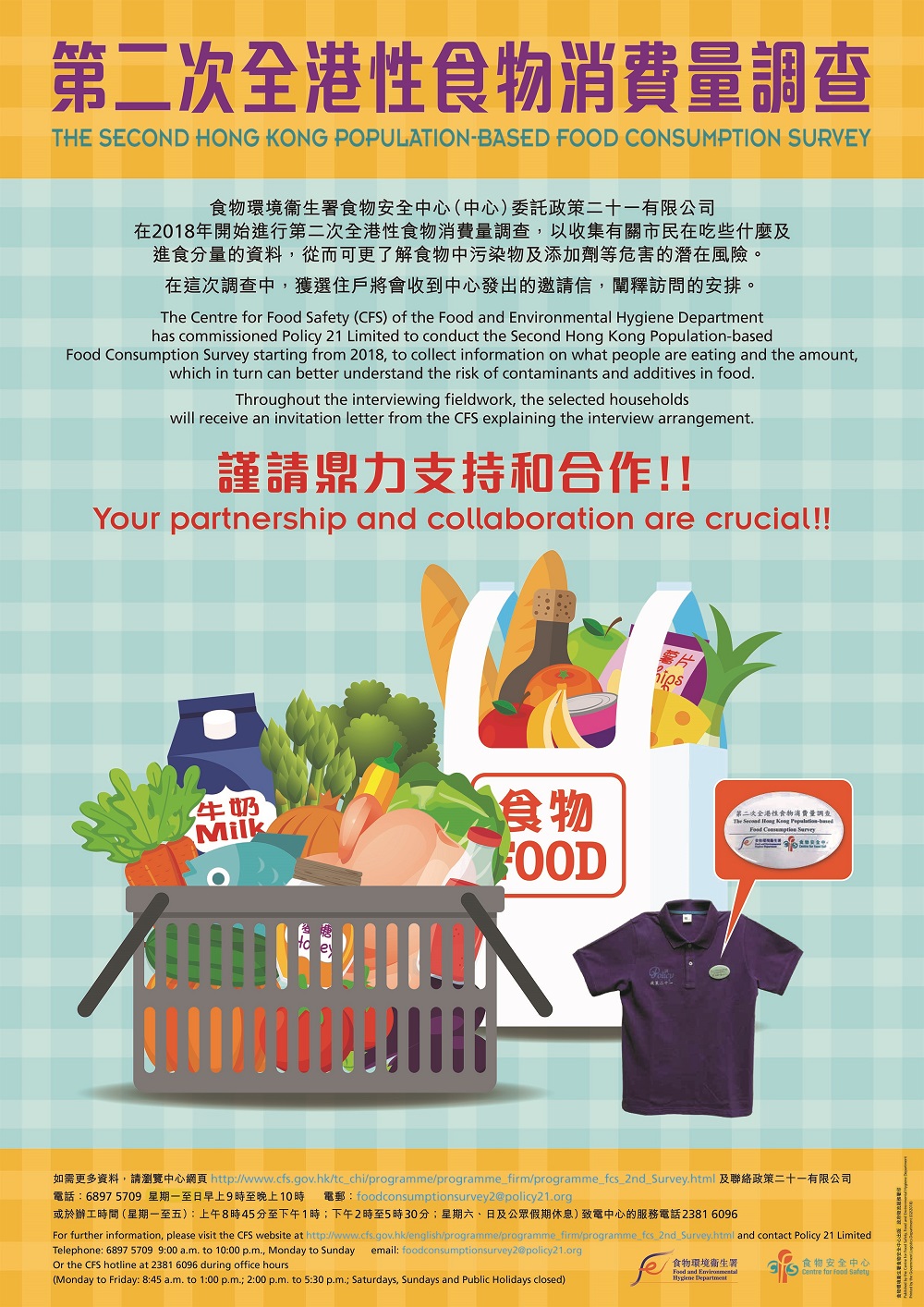
Food consumption information is vital to the Government in assessing food safety risk, formulating public policies and targeting education strategies to promote food safety in Hong Kong. The first Hong Kong Population-based Food Consumption Survey was conducted by the Government in 2005-07. Nonetheless, due to changes in dietary habits over time, it is necessary to update food consumption survey data by conducting the Second Hong Kong Population-based Food Consumption Survey, so that risk assessment can produce accurate and reliable results and conclusions.
The main fieldwork of the Second Hong Kong Population-based Food Consumption Survey will commence in 2018. The CFS will select household addresses all over the territory through an anonymous and scientific sampling procedure and invite around 5,000 eligible people for interview. As participants will be selected following strict sampling procedures, they cannot be replaced such that the reliability of the survey results will not be affected. The CFS will issue invitation letters to selected households to explain the interview arrangement.
For more information, please visit the following website:
http://www.cfs.gov.hk/english/programme/programme_firm/programme_fcs_2nd_Survey.html
Upcoming Activities
Trade Talk
The CFS will organise the next annual Trade Talk and Workshop on HACCP (i.e. Hazard Analysis and Critical Control Point) to enhance food safety by promoting proper food processing procedures among food handlers and adoption of the HACCP System in the trade. Some of the seminars will focus on specific food items (e.g. high-risk foods, Siu Mei and Lo Mei) and provide in-depth briefings for the participants. There will also be seminars on topics such as 5 Keys to Food Safety to help customers enjoy food with peace of mind.

The seminars will be conducted in Cantonese and held at different venues in various districts. Admission is free of charge. Participants will receive a certificate of attendance and a souvenir. The CFS will start issuing letters to members of the trade to invite them to the seminars. Interested parties from the trade can check the CFS website (www.cfs.gov.hk) for the latest posts.
Food Safety Q&A
How to Eat Healthy When Dining Out?
Busy lives and hectic work schedules make eating out inevitable for Hong Kong people. Some may even have three main meals of the day at restaurants. However, many restaurants cook with a lot of oil, salt, sugar and sauces to enhance the appearance, flavour and taste of their dishes. Excessive intake of oil, salt (sodium) and sugar over a prolonged period of time may increase the risks of developing illnesses such as hypertension and coronary heart disease. What can the trade do to ensure that customers could enjoy convenient and tasteful meals while having healthy and nutritious food at the same time? In fact, most restaurants can provide customers with healthy food choices without affecting business operation.
1) More Food Choices
Meat with less fat content and skinned poultry can be used as ingredients of dishes in designing menus. Restaurants can also prepare food by steaming, blanching, braising, stewing or baking, and increase the proportion of vegetables in their dishes.
2) Sauce Served on the Side
The sauce of a dish can be served on the side so that customers can add it to the dish according to their personal preferences. The sauce can also be reduced or skipped, if customers so wish.
3) Reduced Use of Oil, Salt and Sugar, Participation in the “EatSmart@restaurant.hk” Campaign and “Reduce Salt, Sugar, Oil. We Do!” Programme
Minimise the use of oil, salt and sugar in cooking. Food premises are encouraged to join the “EatSmart@restaurant.hk” Campaign of the Department of Health and provide “3 Less” (less oil, salt and sugar) dishes on their menus, or to take part in the “Reduce Salt, Sugar, Fat. We Do!” Programme of the CFS and provide customers with more healthy food choices.
4) Serve Syrup on the Side
In some restaurants, drinks are sweetened with sugar before they are served. It is advisable to serve sugar/syrup on the side so that customers can adjust the sweetness of the drinks by themselves to avoid excessive intake of sugar. Restaurants can also provide “lightly sweetened” (reduced sugar) or “unsweetened” (no sugar) options upon the requests of customers.
We hope that the trade will take the above points into consideration and reduce oil, salt and sugar in their dishes more effectively to promote healthy eating to customers.
Truth against Fallacy
The Saltier the Tastier?
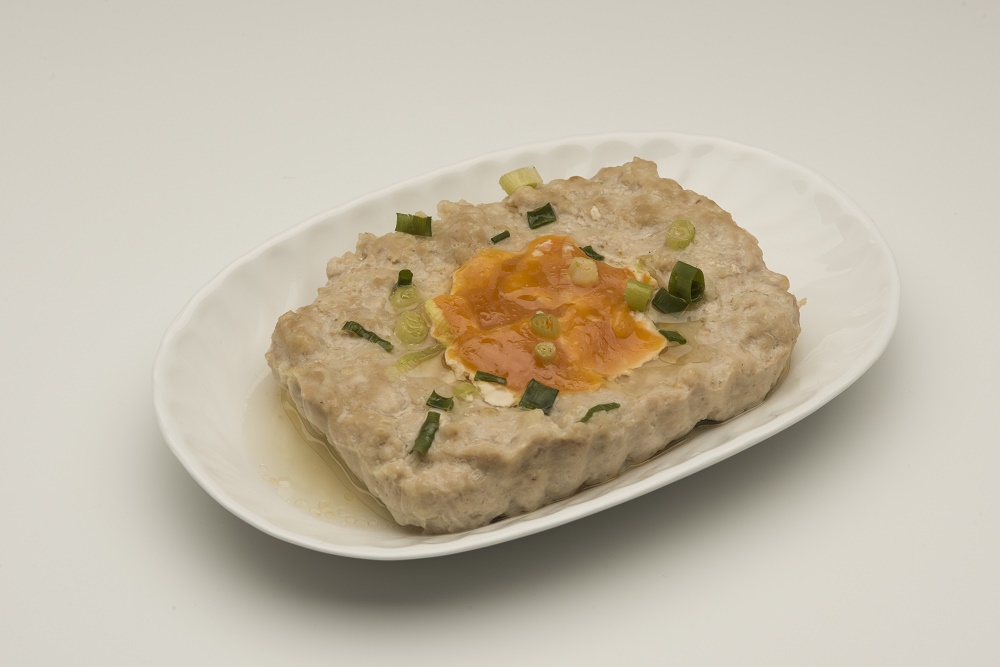
The CFS has invited members of the Consumer Liaison Group to a taste testing in which participants tried the steamed minced pork patties with salted egg made with three different recipes:
| Steamed minced pork patties with salted egg | Sodium content per 100g |
|---|---|
|
Original recipe |
860mg |
|
Reduced-salt recipe 1 |
660mg |
|
Reduced-salt recipe 2 |
150mg |
Note: Containing more than 600mg of sodium per 100g of food = High in sodium content
The test results revealed that most participants preferred the patties with the lowest sodium content (i.e. reduced-sodium recipe 2).
Thus, it can be seen that salty is not necessarily tasty.
According to the Report of Population Health Survey 2014/2015 of the Department of Health, 86.3% of the local population aged 15 to 84 had an average daily salt intake of 8.8g (about 3,520mg of sodium), which exceeded the maximum daily intake (5g of salt or 2,000mg of sodium) recommended by the WHO.
The report also revealed that about 27.7% of people had hypertension. Hypertension, or high blood pressure, is a chronic disease. It can lead to serious illnesses or health problems, including stroke and heart disease. Most of the patients with hypertension are of unknown causes. A small proportion of patients have the disease because of other illnesses, such as kidney diseases or endocrine disorders. The WHO pointed out that a maximum sodium intake of 2,000mg per day for adults could help lower the risk of hypertension.
Sodium (salt) intake in our daily meals should be reduced as far as practicable. For example, we should avoid over-consuming snacks high in salt and eat less processed meats and preserved vegetables. When cooking, substitute spices for or cut down on sodium-containing seasonings. In addition, parents should guide their children in the right choices of food/snacks and help them develop a healthy eating habit at an early age.
When eating out, apart from choosing dishes with more vegetables, we can order dishes of lower sodium content, ask for “less salt”, “less sauce” options, or request sauces to be served on the side.
Remember: Less salt and less sugar: it's your call!
Brain Gym
- Food-borne diseases, including those caused by “superbugs”, can be effectively prevented if the 5 Keys to Food Safety are followed in the storage and preparation of food.
- A natural colour known as “betacyanins” is present in red flesh dragon fruits. The chromophore in betacyanins is stable and will not be easily decomposed by the human digestive system. Betacyanins are eliminated from the body in urine/faeces, and may cause urine/faeces to take on a pink tinge.
- Damaged or mouldy fruits, particularly apples, may contain patulin, which is produced by a number of different moulds.
- Eating too much sodium (salt) for a long period of time can increase the risk of chronic diseases such as high blood pressure.
- The theme for Food Safety Day 2017 was Hong Kong's Action on Salt and Sugar Reduction: Read Labels, Choose Smartly.
Enquiries and Subscription
Printed copies of the Food Safety Bulletin can be obtained from the Communication Resource Unit at 8/F, Fa Yuen Street Municipal Services Building, 123A Fa Yuen Street, Mong Kok, Kowloon. For enquiries, please call 2381 6096. The public may also visit the CFS website ( www.cfs.gov.hk ) for the online version.

